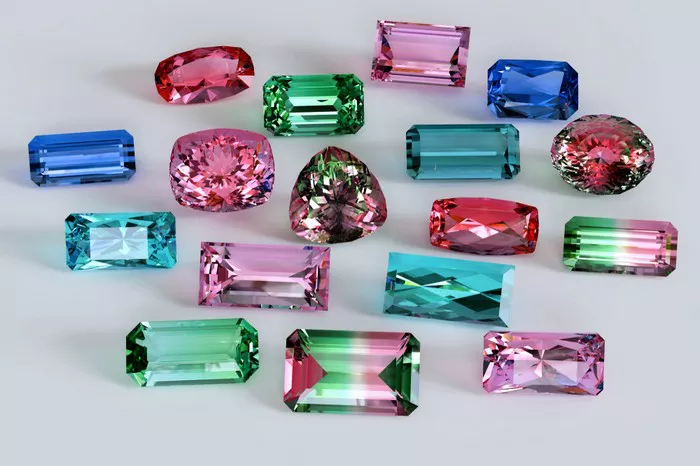Jewelry appraisal is a profession that requires both a keen eye for detail and a deep understanding of gemstone properties. Among the various gemstones, amethyst and black tourmaline are particularly popular due to their unique beauty and symbolic meanings. However, with the rise of counterfeiting techniques, distinguishing genuine from fake gemstones has become increasingly challenging. This article will provide a detailed introduction on how to distinguish true and false amethyst and black tourmaline necklaces from a professional perspective, using simple sentences and logical reasoning.
Understanding Amethyst
Definition and Characteristics
Amethyst is a type of quartz with a purplish hue, ranging from light lavender to deep violet. It is a semi-precious gemstone known for its calming and soothing energy. As a natural crystal, amethyst has a unique internal structure that gives it a distinctive appearance under light.
Color and Transparency
The color of amethyst is its most striking feature. Natural amethyst exhibits a rich, even purple color, which may vary slightly depending on lighting conditions. When examining an amethyst necklace, pay attention to its color uniformity and transparency. Genuine amethyst tends to have a slightly translucent appearance, allowing light to pass through while still showing internal structures.
Hardness and Density
Amethyst has a hardness of 7 on the Mohs scale, making it relatively scratch-resistant. Its density is also unique, which can be used as a reference for identification. When identifying amethyst, tools such as hardness testers and density meters can be used to verify its authenticity.
Thermal Conductivity
Like other crystals, amethyst has a relatively low thermal conductivity. You can lightly lick the surface of the gemstone. If it feels cooler than glass, it is likely genuine. However, this method should be used with caution, as prolonged contact with saliva may damage the gemstone.
Internal Structures
Examining the internal structures of amethyst under a microscope can reveal its authenticity. Natural amethyst often contains inclusions such as bubbles, cracks, or mineral deposits. These imperfections are natural and are difficult to replicate in synthetic gemstones.
Understanding Black Tourmaline
Definition and Formation
Black tourmaline, also known as schorl, is a type of borate silicate mineral. It forms through the rapid cooling of volcanic lava, resulting in a natural glass-like appearance. Its main component is silicon dioxide, making it a non-pure crystalline gemstone.
Appearance and Characteristics
Black tourmaline is characterized by its deep black color and metallic luster. Its hardness is relatively high, ranging from 6.5 to 7.5 on the Mohs scale, making it resistant to scratches and wear. When polished, black tourmaline can exhibit a unique vitreous luster and may even show a rainbow-like reflection under certain lighting conditions.
Identifying Features
The most distinctive feature of black tourmaline is its “rainbow eye” effect. This effect is caused by the reflection of light on the internal structures of the gemstone. When illuminated with a strong light source, black tourmaline may exhibit a colorful glow that resembles a rainbow. This feature is difficult to replicate in synthetic gemstones and is therefore an important identifier.
Temperature Perception
Similar to amethyst, black tourmaline has a relatively low thermal conductivity. When lightly licked, it should feel cooler than glass. However, this method should be used with caution to avoid damaging the gemstone.
Sand Holes and Bubbles
Natural black tourmaline, being a natural glass, may contain sand holes or cracks after polishing. These imperfections are natural and add to the gemstone’s charm. In contrast, synthetic black tourmaline, often made of glass, may contain bubbles or other imperfections unique to glass manufacturing processes.
Distinguishing True and False Gemstones
Lighting Inspection
For both amethyst and black tourmaline, lighting inspection is a crucial step. Use a strong flashlight to illuminate the gemstones. Genuine amethyst will exhibit a translucent purple hue, while genuine black tourmaline may show a colorful glow or rainbow eye effect. Synthetic gemstones, on the other hand, may appear darker or more opaque and may not exhibit these effects.
Sand Holes and Bubbles Examination
Examine the gemstones for sand holes, cracks, or bubbles. Natural amethyst and black tourmaline may contain these imperfections, which are difficult to replicate in synthetic gemstones. If the gemstone appears too perfect or flawless, it may be synthetic.
Density and Hardness Testing
Use professional tools to test the density and hardness of the gemstones. Genuine amethyst and black tourmaline have unique density and hardness values that can be used for identification. Synthetic gemstones may have similar values, but careful testing can reveal differences.
Thermal Conductivity Test
While not as reliable as other methods, thermal conductivity testing can provide additional information. Gently lick the surface of the gemstone and feel its temperature. Genuine amethyst and black tourmaline should feel cooler than glass. However, this method should be used with caution to avoid damaging the gemstone.
Microscopic Examination
For more accurate identification, microscopic examination of the gemstones’ internal structures is recommended. Natural amethyst and black tourmaline have unique internal structures that can be difficult to replicate in synthetic gemstones. By examining these structures under a microscope, one can obtain more definitive results.
Price Consideration
Finally, price can also be a consideration when distinguishing true and false gemstones. Genuine amethyst and black tourmaline are relatively rare and therefore tend to be more expensive. If a gemstone is priced unusually low, it may be synthetic or of poor quality.
Conclusion
Distinguishing true and false amethyst and black tourmaline necklaces requires a combination of lighting inspection, sand hole and bubble examination, density and hardness testing, thermal conductivity testing, microscopic examination, and price consideration. By carefully following these steps and using professional tools, one can accurately identify genuine gemstones and avoid being deceived by counterfeits. Remember, the beauty and value of gemstones lie not only in their appearance but also in their authenticity and uniqueness.
Related topic:
- What Are the Different Characteristics of Obsidian and Black Tourmaline?
- Do You Understand the Price Difference Between Obsidian and Black Tourmaline?
- Can Obsidian and Black Tourmaline Be Worn Together?


